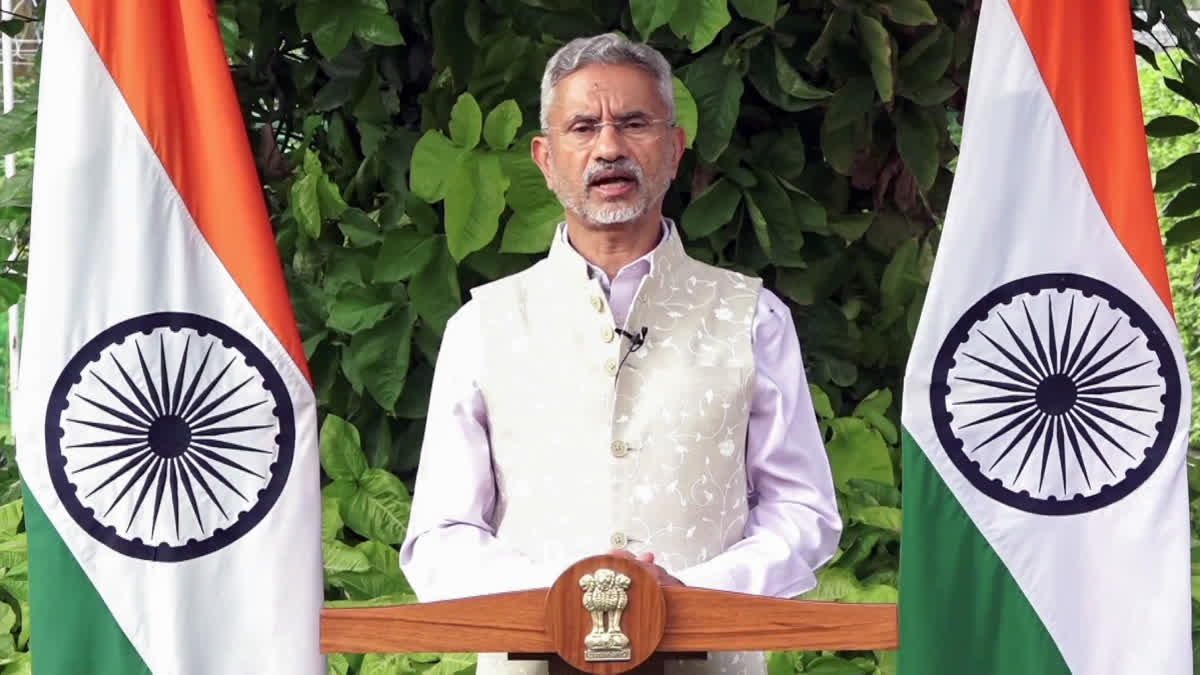New Delhi: Assam Chief Minister Himanta Biswa Sarma's meeting with External Affairs Minister S Jaishankar ahead of the latter's departure for Vientiane, Laos, for this year’s Foreign Ministers’ Meetings under the Association of Southeast Asian Nations (ASEAN) framework is yet another manifestation of the importance India's northeastern region lays to ties with Southeast Asian countries.
"Pleased to meet Chief Minister of Assam @himantabiswa in South Block today," Jaishankar posted on his X handle following the meeting on Tuesday. "Discussed Act East and BIMSTEC policies and how Assam can contribute to our Neighborhood First approach."
On his part, Sarma said that during his meeting with Jaishankar, both of them deliberated upon a constructive role for Assam to strengthen Prime Minister Narendra Modi’s Act East Policy. Writing on his own X handle, Sarma stated that the possibilities of "encouraging foreign investors to be a part of the Assam growth story and firmly establishing our state as a preferred gateway to Southeast Asia" formed part of the discussions.
During the course of his visit, Jaishankar will participate in the Foreign Ministers’ Meetings under the ASEAN framework in the format of ASEAN-India, East Asia Summit (EAS) and the ASEAN Regional Forum (ARF).
"The visit underlines India's deep engagement with and the importance India attaches to the ASEAN-centred regional architecture, our strong commitment to ASEAN unity, ASEAN centrality, the ASEAN Outlook on the Indo-Pacific (AOIP) and taking forward the ASEAN-India Comprehensive Strategic Partnership," a statement issued by the External Affairs Ministry reads. "It is of particular significance that this year marks a decade of India's Act East Policy which was announced by THE Prime Minister at the 9th East Asia Summit in 2014."
What is the importance of the Northeast in terms of India-ASEAN relations?
Under the Act East Policy, the Northeast, which shares historical and traditional bonds with the ASEAN region, is seen as the springboard for India’s increasing engagements with Southeast Asia. Both the Indian government and the ASEAN have the intent to explore opportunities in the Northeast to strengthen bilateral ties between New Delhi and the 10-nation bloc.
The Northeast is the region that is in the closest geographical proximity to the ASEAN countries. In fact, New Delhi formulated the Look East Policy in the early 1990s and the Act East Policy in 2014 precisely to leverage this geographical proximity.
In fact, in May this year, when the Fourth Joint Committee meeting for the review of the ASEAN-India Trade in Goods Agreement (AITIGA) was held in Putrajaya, Malaysia, the focus was again back on the role India's northeastern region can play in this regard.
The AITIGA is a comprehensive trade agreement between the ASEAN and India, aimed at promoting bilateral trade and economic cooperation. Negotiations for the agreement began in 2003 and were concluded in 2009, with the agreement entering into force on January 1, 2010.
One of the central objectives of AITIGA is the reduction and eventual elimination of tariffs on goods traded between ASEAN member states and India. Under the agreement, both sides have committed to gradually reducing tariffs on a wide range of products over specified periods. These measures include simplifying customs procedures, enhancing transparency, and reducing non-tariff barriers to trade, thereby making it easier and more cost-effective for businesses to engage in cross-border trade.
What are the challenges that the Northeast faces in playing a more pivotal role in India-ASEAN relations and trade?
The ASEAN is one of the major trade partners of India with a share of 11 per cent in India's global trade. However, the fact of the matter is that the Northeast's potential is yet to be exploited to boost bilateral economic and political ties between India and the ASEAN. For example, though India-ASEAN bilateral trade stood at $122.67 billion in 2023-24, the Northeast accounted for only a meagre five per cent of it. The rest of the trade originated from states in other parts of India.
Though a number of diplomatic and business delegations from the ASEAN visited the Northeast since the turn of the century and in the 2000s primarily to explore business and investment opportunities in the region, challenges like governance, ease of doing business, connectivity and security are discouraging them from taking the process forward.
In terms of governance, the ASEAN has found that the northeastern states have poor institutional mechanism to handle issues such as corruption, efficiency, accountability and monitoring implementation of projects. Barring Assam’s main city of Guwahati, other states of the region have not set up systems or created an environment that is conducive for ease of business. Making people engaging in malpractices accountable is a major challenge in the region. Here, the issue of infrastructure also comes into focus. The infrastructure in the region is very poor compared to other parts of India.
On the connectivity side, though the Northeast is in close proximity with Southeast Asia, land connectivity is yet to materialise because of the endless political turmoil in Myanmar. Any interaction that happens between Southeast Asia and northeastern India has to pass through Myanmar.
The 1,360-km-long India-Myanmar-Thailand trilateral highway project connecting Moreh in Manipur and Mae Sot in Thailand has long been delayed due to the situation in Myanmar. Actual construction work on upgrading road segments began around 2012 in all three countries. However, due to political instability and civil unrest in Myanmar, 30 per cent of the work is yet to be completed.
As of now, trade between India and the ASEAN nations is mainly happening through maritime and aerial routes. But it is the land connectivity between the Northeast and Southeast Asia that the ASEAN countries are more interested in because then it will become a permanent feature.
What is the potential of the Northeast in becoming a catalyst in boosting India-ASEAN ties?
The biggest potential of the Northeast is its natural resources. In terms of products, primary goods can be exported from the Northeast and not manufactured goods as industries are minimal in the region. According to experts, the ASEAN nations are interested in agro-based industries as the region is rich in organic fruits and vegetables. Processing of such agricultural products is of interest for them.
Another area sector is tourism. Northeast India and Southeast Asia share historical, cultural and religious (Buddhist) ties. The ASEAN countries can invest in the hospitality sector.
Human resources in the Northeast is an area that the ASEAN nations can benefit by investing in. Youth in the region can be imparted training for capacity building and skilling. They can then go to the Southeast Asian nations as migrant workers. Experts are of the view that the ASEAN member states can also invest in small and medium enterprises (SMEs) in the Northeast such as manufacturing of bamboo-based products. It now remains to be seen how far Jaishankar can push forward this agenda during the deliberations with his counterparts from the ASEAN nations in Laos.



